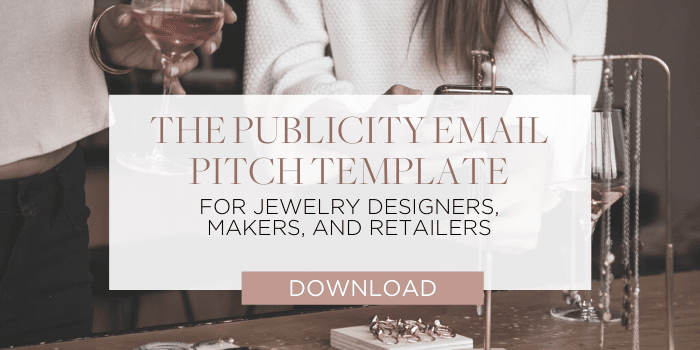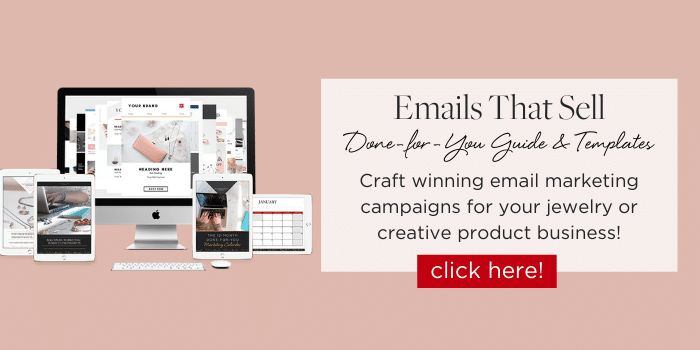How to Write an Email to Get Featured in a Magazine or Podcast

For a jewelry business owner, there are few things more exciting than opening the page of your favorite industry magazine to see your designs displayed. Having your products featured in publications like magazines, blogs, and podcasts not only helps drive sales but builds strong brand credibility and authority.
Your website, online store and social media efforts help to establish your online presence, but actively growing your network and pitching your products is one of the most important marketing growth strategies.
While sending an email sounds easy enough, industry influencers and publishers can receive hundreds of pitches a day. So how do you make yours stand out? This article will give you a step by step process on how to write a pitch email to sell your products.
Build a Target Publication List

While there may be hundreds of potential publications that you would like to have your jewelry featured in, not all might be the right fit. In order to maximize your time and energy, some initial research will help you identify the best opportunities.
Understand your customers
The first step in identifying publications you want to align yourself with is to consider your customers’ buying habits.
Create a Buyer Persona
Buyer personas are created to help businesses understand their customers in order to better serve them. Creating a buyer persona helps to develop branding, messaging, product positioning, and allows you to understand their buying habits and browsing activities. Knowing their interests and online activities, you can uncover potential target publications such as bloggers and influencers they might follow.
Some quick tips to developing a buyer persona
- Demographic research: Use tools such as Google Analytics or social media reporting to identify your target audience’s demographic information. You will want to narrow down details such as age, gender, location, basic income level, education, interests, hopes, and challenges.
- Identify their browsing activity: Deep dive into your social media followers to understand what their interests are and other sites they have a relationship with. Do they follow certain online publications, competitors, or engage in social groups and forums? Make a list of both industry specific publications and parallel industry resources that might also be a good fit to feature your jewelry.
Find out where your competitors are featured
Another great resource for building your target publication list is to examine backlinks your competitors have received for their products. A backlink is when another online resource such as a blog, links back to your website or product page from their site.
Online tools such as Ahrefs or SEMRush can provide these types of analyses. Chances are if these online publications are already linking to your competitors, there is a good probability they might be interested in your product as well.
You can also Google your competitors and their product names to find out which publications they are partnered with.
Create and segment your target publication list
Using a program like Excel or Google Sheets, we recommend creating one document where you can list all of your publication targets, contacts for those publications, and pitch dates. This will help you keep track of all your outreach activities and successes.
Segmenting your list
You should start by segmenting your list into publication types such as:
- Fashion Magazines
- Jewelry/Fashion Blogs
- Influencers
- Podcasts
An editorial magazine pitch will certainly look different than pitching an Instagram influencer. Additionally you can prioritize each of the publications based on their reader base, traffic, or social media following. Bigger magazines and blogs will have far more reach but are most likely tougher to get in front of than smaller, more local sites.
Understand your audience
Once your list is segmented and prioritized you can then start to take a look at the various types of publications to get a better idea of the content they feature and who writes that content.
Many publications may offer a “guest post” or “how to send a pitch” page on their website. If you come across a resource like that be sure to read it thoroughly and follow the directions. You wouldn’t want your email deleted over a small detail like forgetting to put your company name in the subject line.
If your target audience for your pitch email is a fashion influencer, find out what motivates and drives him or her. What are their interests? How can you connect to them in a way that will stand out and get your email noticed above the others?
If you are angling for a podcast interview to discuss your jewelry line, you should listen to a few other interviews to understand what sort of questions or topic material they may want to cover and use that in your pitch.
The inbox of a fashion editor of a big magazine is most likely bombarded with dozens of pitch emails daily. How can your email be interesting, engaging, and concise enough to grab their attention? Take a look at some of their recent articles they have written and notice what stands out and the types of content they cover. Referencing someone’s work is a great way to start a conversation.
For each publication and contact you research, add the notes in your document next to the publication so you will have that information saved.
Identify email addresses and contacts
Sometimes publications will offer an “editorial staff” page with a list of contributors or writers complete with full names and email addresses. Magazines tend to offer this or bigger blog sites but most of the time, finding the right contact to connect with can be a challenge. Ideally, sending an email to a generic address like “[email protected]” probably isn’t going to land you a response. Your goal should be to find a live person to connect with.
Below are a few steps you can take to find someone’s email address.
- Search the publication’s “about us” page or staff page for a list of writers and editors. Choose the writer that best fits your criteria in terms of what they typically cover (jewelry, fashion, collections, etc).
- If there is no staff page available, check the author byline on any blog pages or articles and see if it links to a profile which includes contact information.
- If the above two options don’t work, you can turn to Twitter or LinkedIn to get a list of the company’s employees and potentially find a contact that might represent the person you are trying to locate.
- Lastly, there are various email outreach tools and plugins available with both paid and free versions that can help you identify email addresses. Tools like Hunter.io will populate contact names and email addresses based on company or website searches.
How to Write a Pitch Email to Sell a Product

Now that you have your list of target publications and contacts, it’s time to get started sending your pitch emails!
- Send your email from a business address
It’s best to use a professional business or company email address over a personal email account. Be sure to include a signature with contact information such as name, email, address, and a link to your website.
If you plan on making outreach emails part of your email marketing strategy, which you should, you might want to consider investing in an email marketing tool such as MailChimp or Klaviyo
- Start off strong with a solid subject line
According to Optinmonster, 47% of email recipients open an email based solely on the subject line. Essentially, your subject line could be the difference between an “open” and “delete”.
Subject lines should entice the reader to click. They should be concise but interesting enough to pique one’s interest. Here are a few tips to follow:
- Ideally, your subject line should be no more than 50 characters and contain an average of 5-8 words.
- Don’t be salesy. Avoid unnecessary punctuation like exclamation marks or all capital letters.
- Use personalization elements such as the person’s name in the subject line.
- The use of questions in subject lines can pique curiosity and sound like the beginning of an interesting conversation.
- Don’t be afraid to be funny or quirky to try and grab the reader’s attention. If you do use humor though, be careful not to get too carried away. Keep it relevant.
- Examples of strong subject lines:
- (Contact name), your readers will love (your product name)
- Check out the crown jewel of (your product type) [sample included]
- Don’t wear last year’s styles
- (Contact name) you’d look awesome in (your product)
- (Contact name) have you seen this yet?
- Your customer’s beauty issues solved
- Pitching a magazine or podcast
A strong subject line is only the first step to get them to open your email, the rest of the pitch will determine whether you get a response. Pitches to publications like magazines and podcasts should clearly express the value they will receive from working with you.
- Start with a personal greeting
Again, personalization goes a long way. If you’ve done your homework, you should know the first name of the person you’re reaching out to. Include that in your greeting
- Paragraph 1: Introduction
Your first line or two should explain who you are and establish a personal connection if possible. This is a good opportunity to let them know some information such as how you found them, maybe how you’re an avid reader, or have enjoyed one of their podcasts or articles. This part should be powerful, yet short and sweet.
- Paragraph 2: The pitch
This is the hook, line, and sinker of your email. In 3-5 sentences you should explain what it is you’re looking for and the value you’re giving them. If you’re pitching your product to be included in a magazine, or asking for a podcast interview, be clear about what you want.
You should consider the following questions when writing your pitch:
- What makes you/your product unique?
- What makes you/your product a good fit?
- How will their customers or readers benefit?
- How will the contact benefit?
- Paragraph 3: Credentials
In 2-3 sentences or even a bulleted list, you can backup your claims by listing and linking to other articles or podcasts you've been featured in. This would also be a good place to provide more information about your product.
- Closing line and Call to action
If you didn’t make your request from them clear above, this is the last time to do it. Be direct about it and give them a call to action. What do you want them to do?
Thank them for their time and express excitement in hearing from them and be willing to provide more information as needed. Sometimes asking a question here can keep the tone more conversational and prompt a response.
If you would like some more examples, here is a list of some great product email pitch templates.
- Follow Up
You’ve sent your killer pitch email expecting to sit back and watch your inbox flood with responses but it’s been about a week and it’s still empty. What’s going on? According to a study from Backlinko, 91.5% of outreach emails are ignored.
Say what?
Yes, it’s a harsh reality that people are less likely to respond the first time around but according to that same study, sending a follow up message can improve your response rate by 65.8%. The follow up email is almost more important than the original.
When and how many times to reach out
Their recommendation is to send 1-3 follow up emails. Repetition is more likely to get a response than the one-off pitch.
There is no hard and fast rule about when you should follow up, but the average is 1-3 days depending upon the opportunity and urgency of your quest.
How to write the follow up pitch email
- Your follow up should be short and sweet and polite.
- Express understanding that they are probably super busy or might have missed your email but you wanted to make sure they saw it.
- Be sure to forward your initial email so it’s easy for them to reference in the chain.
- This is another good opportunity to offer additional information or repeat your request.
Check out our tips for writing emails that convert for more details on how to get a response.
Maximizing Your Exposure
Congratulations! Your outreach efforts have paid off and your jewelry has been featured. This is fantastic recognition for your brand as well as existing news to share with your customers. Ride this wave as long as you can. Using the momentum of being featured can lead to more features. Here are some tips for maximizing your exposure.
- Include a link to the article or podcast in all of your new outreach emails.
- Feature your success on your website and social media channels. Be sure to share links through posts or live stories with your social media followers.
- Add a link to your target publication list and keep that contact on file for future opportunities.
If you want to take your email marketing strategies to the next level, you're going to want to take advantage of the Emails That Sell Done-for-You Bundle.
This guide makes email marketing easy with email templates, 500+ email subject lines, marketing calendars, and so much more to help you get a handle on email so you can get back to the fun parts of your business.

